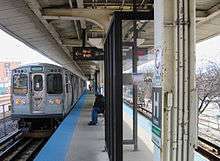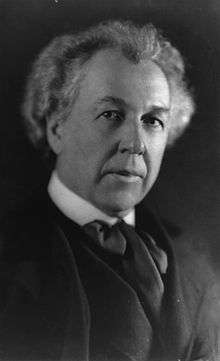Oak Park, Illinois
| Oak Park, Illinois | |
| Village of Oak Park, Illinois | |
| Village | |
 Lake Street at dusk | |
| Country | United States |
|---|---|
| State | Illinois |
| County | Cook |
| Township | Oak Park |
| Municipality | Village |
| Coordinates | 41°53′N 87°48′W / 41.883°N 87.800°WCoordinates: 41°53′N 87°48′W / 41.883°N 87.800°W |
| Area | 4.70 sq mi (12 km2) |
| - land | 4.70 sq mi (12 km2) |
| - water | 0.00 sq mi (0 km2) |
| Population | 51,878 (2010) |
| Density | 11,037.9/sq mi (4,262/km2) |
| Founded | Settled |
| Date | 1830s |
| Government | Oak Park Board of Trustees |
| - location | Village Hall |
| - coordinates | 41°48′N 87°48′W / 41.8°N 87.8°W |
| Timezone | CST (UTC-6) |
| - summer (DST) | CDT (UTC-5) |
| Postal code | 60301 to 60304 |
| Area code | 708 |
 Location in Cook County and the state of Illinois.
| |
.svg.png) Location of Illinois in the United States
| |
| Wikimedia Commons: Oak Park, Illinois | |
| Website: www | |
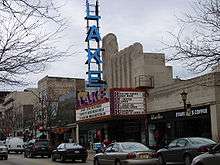
Oak Park is a village adjacent to the West Side of the city of Chicago in Cook County, Illinois, United States. It is the 29th largest municipality in Illinois as measured by population in the 2010 US Census,[1] and has easy access to downtown Chicago (the Chicago Loop) via public transportation including the CTA Blue and Green lines, buses, and Metra commuter rail. Pace buses serve the Village for travel within its borders and connecting to neighboring suburbs. As of the 2010 United States Census the Village had a total population of 51,878.[2]
Oak Park was settled beginning in the 1830s, with rapid growth later in the 19th century and early 20th century. It incorporated in 1902, breaking off from Cicero. Development was spurred by railroads and street cars connecting the village to jobs in Chicago. Famed architect Frank Lloyd Wright and his wife settled here in 1889. Population peaked at 66,015 in 1940. Smaller families led to falling population in the same number of homes and apartments. In the 1960s, Oak Park faced the challenge of racial integration, devising many strategies to integrate rather than re-segregate the village, which so far are successful. Oak Park includes three historic districts for the historic homes: Ridgeland, Frank Lloyd Wright and Seward Gunderson, reflecting the focus on historic preservation. Many people of national fame have been born here, or lived here while building their own families and careers, including Frank Lloyd Wright, Ernest Hemingway, Ray Kroc, Bob Newhart, Betty White and Dan Castellaneta.
History
In 1835, Joseph Kettlestrings, an immigrant from England, purchased 172 acres (70 ha)[3] of land just west of Chicago for a farm and their home. Once their children were born, they moved to Chicago for the schools in 1843, and moved back again in 1855 to build a more substantial home a bit east on their quarter section of land. More farmers and settlers had entered the area. Their land was called by several names locally, including Oak Ridge. When the first post office was set up, it could not use the name Oak Ridge as another post office was using that name in Illinois, so the post office chose Oak Park, and that name became the name for the settlement as it grew, and for the town when it incorporated in 1902.[3]
By 1850, the Galena and Chicago Union Railroad was constructed as far as Elgin, Illinois, and passed through the settlement area.[4] In the 1850s the land on which Oak Park sits was part of the new Chicago suburb, the town of Cicero. The population of the area boomed during the 1870s, with Chicago residents resettling in Cicero following the Great Chicago Fire of 1871 and the expansion of railroads and street cars to the area. "In 1872, when Oak Park received its own railroad depot on the Chicago and Northwestern Railway, its rapid emergence as a residential suburb of Chicago began. In 1877, the railroad was running thirty-nine trains daily between Oak Park and Chicago; in the subsequent year, more railroads and street car lines, with increased service, came to link Oak Park and Chicago. As Chicago grew from a regional center to a national metropolis Oak Park expanded – from 500 residents in 1872 to 1,812 in 1890, to 9,353 in 1900, to 20,911 in 1910, to 39,585 in 1920. Oak Park thus emerged as a leading Chicago suburb."[5]
A review of Oak Park's history by Wiss, Janny, Elstner Associates in 2006 further explains the importance of railroads and street cars in the development of Oak Park:
As suburban residential development continued in the 1880s and 1890s, streetcars and elevated trains supplemented the original main line steam railroads to connect Oak Park commuters to jobs in downtown Chicago. One of the first streetcar lines was the Chicago, Harlem, & Batavia “dummy” line, which ran approximately along the present-day route of the Eisenhower Expressway. The “dummy” trains used a miniature steam locomotive with a false cladding designed to conceal most of the moving parts and avoid startling horses. This line first began operation in 1881, but did not provide direct commuter service to downtown Chicago until June 1888. A more extensive streetcar network throughout Oak Park was opened in 1890. In the future village of Oak Park, this system ran east-west on Madison Street and Lake Street, with a north-south connection on Harlem Avenue. Streetcar service was discontinued in 1947, to be replaced by buses. The Lake Street Elevated Railroad (today’s CTA Green Line) was extended into Oak Park in 1899–1901, although the trains ran at ground level until the 1960s. The Metropolitan West Side Elevated Railroad (today’s CTA Blue Line) was extended into Oak Park in 1905, providing local service over tracks originally placed by the Chicago Aurora & Elgin electric interurban train. The “Met” line moved onto new tracks along the Congress (Eisenhower) Expressway in 1958.[6]
The Village of Oak Park was formally established in 1902, disengaging from Cicero following a referendum. According to the local historical society, "The period 1892-1950 saw the construction of almost all of the housing stock in Oak Park, and most of the village's current buildings."[3] The village population grew quickly, and "by 1930, the village had a population of 64,000, even larger than the current population",[3] while cherishing a reputation as the "World's Largest Village."[3] Chicago grew rapidly in the 19th century, recording 4,470 residing in the 1840 Census in the place so recently a fur trading post, reaching 1,099,850 in 1890, and then 1,698,575 in 1900, passing Philadelphia to the number two spot in the US, and in that year, the fifth largest in the world. Chicago was well located on the shores of Lake Michigan for transport; after the fire of 1871, Chicago rebuilt its center and exploded with new ideas; Oak Park grew along with its neighbor to the east, having location and railroad and street car connections in its favor.
After World War II, "Oak Park was affected by larger developmental trends in the Chicago Metropolitan area. The construction of the Eisenhower Expressway cut through the southern portion of the Village in the mid 1950s. Starting in the 1960s and 1970s, Oak Park has made a conscious effort to accommodate changing demographics and social pressures while maintaining the suburban character that has long made the Village a desirable residential location.[6] Beginning in the 1960s, Oak Park faced the issue of racial integration with effective programs to maintain the character and stability of the Village, while encouraging integration on racial basis. This was perhaps the greatest challenge to Oak Park, which some judge it has met with success, see #Demographics. Population fell from the peak level, primarily from smaller average household size, including a rise in one-person households.
Oak Park has a history of alcohol prohibition. When the village was incorporated, no alcohol was allowed to be sold within its village limits. This law was relaxed in 1973, when restaurants and hotels were allowed to serve alcohol with meals, and was further loosened in 2002, when select grocery stores received governmental permission to sell packaged liquor. Now alcohol, such as beer and wine, is easily accessible.
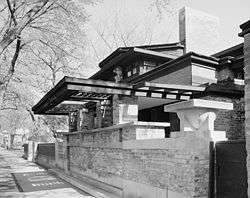
In 1889, Frank Lloyd Wright and his wife settled in Oak Park. He built many homes and the Unity Temple, his own church, in the village, before he left in 1911 to settle in Wisconsin. Oak Park attracts architecture buffs and others to view the many Frank Lloyd Wright designed homes found in the village, alongside homes reflecting other architectural styles. The largest collection of Wright-designed residential properties in the world is in Oak Park.[7] A distinct focus on historic preservation of important architectural styles began in the 1970s and continues, with many buildings marked as historically significant, and so far, three historic districts defined. Other attractions include Ernest Hemingway's birthplace home and his boyhood home, the Ernest Hemingway Museum, the three Oak Park homes of writer and Tarzan creator Edgar Rice Burroughs, Wright's Unity Temple, Pleasant Home, and the Oak Park-River Forest Historical Society.
Oak Park and River Forest High School is a comprehensive college preparatory school, with a long list of alumni who have made major or notable contributions to their fields of endeavor. Among these are Nobel Prize-winning author Ernest Hemingway, football Hall-of-Famer George Trafton, McDonald's founder Ray Kroc, city planner Walter Burley Griffin, comedian Kathy Griffin, basketball player Iman Shumpert, and the voice of iconic cartoon character Homer Simpson, Dan Castellaneta.
Geography
Oak Park is located immediately west of the city of Chicago. The boundary between the two municipalities is Austin Boulevard on the east side of Oak Park and North Avenue/Illinois Route 64 on the village's north side. Oak Park borders Cicero along its southern border, Roosevelt Road/Illinois Route 38, from Austin to Lombard; and Berwyn from Lombard to Harlem Avenue. Harlem/Illinois Route 43 serves as its western border, where between Roosevelt and South Boulevard, it borders Forest Park and between North Boulevard and North Avenue to the west it borders River Forest.
The entire village of Oak Park lies on the shore of ancient Lake Chicago, which covered most of the city of Chicago during the last Ice Age, and was the forerunner to today's Lake Michigan. Ridgeland Avenue in eastern Oak Park marks the shoreline of the lake, and was once an actual ridge. As with the geographical setup of the Chicago River, which connects to the present day Lake Michigan just north of the city's Loop, the ancient Des Plaines river once emptied into glacial Lake Chicago, making prehistoric Oak Park a "Plains river Delta" system. One of North America's four continental divides runs through Oak Park. This divide, a slight rise running north-south through the village, separates the Saint Lawrence River watershed from the Mississippi River watershed, and is marked by one plaque on Lake Street at Forest Avenue and another in the northwest corner of Taylor Park.
According to the 2010 census, Oak Park has a total area of 4.7 square miles (12.17 km2), all land.[8]
Transportation
Public transit
Oak Park is accessible from Chicago by service on the Green Line and the Blue Line at four stations in Oak Park. Oak Park also has a station for Metra's Union Pacific / West Line. Bus transit service within Oak Park and to other suburbs is also provided by the CTA and Pace.
Streets, addresses, and expressways
The Eisenhower Expressway is the primary expressway between Chicago and Oak Park. The highway also provides connections to O'Hare International Airport. Major east-west streets in Oak Park continue east into Chicago.
The streets are laid out in a grid pattern, occasionally with local streets ending in a cul-de-sac to maintain local character. Oak Park has its own street numbering system that begins, for east-west streets at Austin Boulevard (no east or west designation), and for north-south streets, at the elevated train tracks located just south of Lake Street, which divides the numbers, getting larger going north or south from there, and requiring north or south designation on addresses. The border streets do not follow the Oak Park numbering system; rather they match the address system with the cities sharing those border streets. For example, addresses on Austin Boulevard match the Chicago system, with the zero line at Madison Street, and along North Avenue, addresses match the Chicago system, with Austin Boulevard at 6000 W and Harlem at 7200 W.
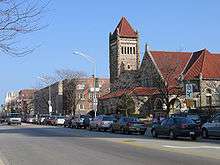
Bicycles
Augusta Boulevard through the village is part of the Grand Illinois Trail; the trailhead of the Illinois Prairie Path is less than a mile from Oak Park. With several cycle clubs and groups, Oak Park is considered a bicycle-friendly community, and the tree-lined streets of the community as well as its proximity to trails in nearly communities attract cyclists to Oak Park, easily accessed by the Green Line, Blue Line, or Metra. Bicycle lanes are marked on many streets throughout Oak Park, though no fully segregated cycle facilities have been put in place.
Bicycle sharing services are coming to the village. Located on Lake Street near Harlem Avenue, Greenline Wheels, one of Illinois' first Low-profit limited liability companies, rents bicycles. Divvy bike sharing, which serves the city of Chicago, will come to Oak Park in 2016.[9]
Demographics
| Historical population | |||
|---|---|---|---|
| Census | Pop. | %± | |
| 1910 | 19,444 | — | |
| 1920 | 39,858 | 105.0% | |
| 1930 | 63,982 | 60.5% | |
| 1940 | 66,015 | 3.2% | |
| 1950 | 63,529 | −3.8% | |
| 1960 | 61,093 | −3.8% | |
| 1970 | 62,511 | 2.3% | |
| 1980 | 54,887 | −12.2% | |
| 1990 | 53,648 | −2.3% | |
| 2000 | 52,524 | −2.1% | |
| 2010 | 51,878 | −1.2% | |
| Est. 2015 | 52,287 | [10] | 0.8% |

As of the 2010 census there were 51,878 people, 22,670 households, and 13,037 families residing in the village. The population density was 11,037.9 people per square mile. The racial makeup of the village was 67.7% White, 21.7% African American, 0.2% American Indian, 4.8% Asian, 2.0% some other race, and 3.6% from two or more races. Hispanic or Latino of any race were 6.8% of the population. In Oak Park, 13.1% spoke a language other than English at home and 10.3% were foreign-born.[12]
For the period 2009-11, the estimated median annual income for a household in the village was $78,384, and the median income for a family was $105,217. Male full-time workers had a median income of $77,760 versus $58,653 for females. The per capita income for the village was $46,687. About 5.9% of families and 8.7% of the population were below the poverty line, including 9.0% of those under age 18 and 4.3% of those age 65 or over.[13]
In the 1960s Oak Parkers began a concerted effort to avoid the destructive racial housing practices occurring in nearby communities. Racial steering and block-by-block panic peddling caused rapid racial change on Chicago's west side, including the Austin Community Area adjacent to Oak Park. Whites left west side neighborhoods based on concerns of property value losses and crime increases, and some businesses left as well. The Village of Oak Park passed a fair housing ordinance in 1968 (in the same year as the federal Fair Housing Act) to ensure equal access to housing in the community. In 1972, the Oak Park Housing Center was founded by Roberta "Bobbie" Raymond to promote integration in the community, by ensuring equal access and discouraging white flight.[14][15] Part of this effort included banning "for sale" signs on houses. Although this law became unconstitutional with the decision in Linmark Associates, Inc. v. Township of Willingboro, usage of the signs is still strongly discouraged by local realtors.[16]
An evaluation of the policy in Oak Park to promote integration, written in the early years of the 21st century noted the gradual increase in the share of Village population that is black, at 22% in 2000, and further observed '"as late as 2000 there were no resegregated census tracts, with tracts ranging from 7% black to 36% black. . . . this was not because the pattern of rapid westward resegregation had run its course, because events in neighboring suburbs showed that segregation trends were still operating. Instead, the pattern in a sense leaped over Oak Park to other suburbs farther west, including Bellwood and Maywood, which resegregated in a relatively short time.[17]
Government
Village
Since 1951 Oak Park has been organized under the council-manager form of municipal government. The village government includes an elected president and an elected village board which hires a village manager to conduct the day-to-day affairs of the administration. Oak Park also has five additional governments which levy real estate taxes. These include the Oak Park Township, the high school district (which also levies from adjacent River Forest), the elementary school district, the library district, and the park district.
The United States Postal Service operates the main Oak Park Post Office at 901 Lake Street and the Oak Park South Post Office at 1116 Garfield Street.
Elections
Oak Park's Village Board, Village President and other elected officials are elected through a two-stage election process. A primary election is used to nominate party candidates, and a general election is used to elect government officials. Oak Park's election turnout varies greatly depending on whether it is a municipal or national election. In the 2012 Presidential Election, Oak Park had the highest voter turnout in suburban Cook County, 79.8% of registered voters cast a ballot.[18] Municipal elections for the Board of Trustees and Village Clerk generally have much lower voter turnout, averaging around 20% and are held in spring, consistent with state law. The municipal elections are considered non-partisan, as the national political parties do not put up the candidates. Candidates step forward, or are found by a citizens group that works to find people to have new candidates for each election cycle, encourage participation in local issues.
School Districts
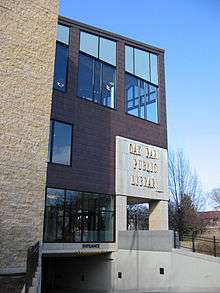
The public primary schools (Lincoln, Mann, Longfellow, Beye, Irving, and Hatch) and the middle schools, Percy Julian Middle School (formerly Nathaniel Hawthorne), are operated by the Oak Park Elementary School District.[19] These schools are part of elementary school District 97, which regularly adopts medium-term strategic plans.[20]
Performance of schools in Oak Park as evaluated by standard statewide tests is released periodically, known as the school report cards.[21]
The renaming of the one junior high school, now middle schools, after prominent African-Americans rather than giant American literary figures was done in part to motivate minority students in their educational pursuits. A gap in school performance, referred to as "this intolerable and persistent inequity,"[22] remains, as of the date of the report.[23]
Oak Park is the home of two high schools: Oak Park and River Forest High School, the sole school in educational District 200, and Fenwick High School. Oak Park and River Forest High School is a public school which is jointly run by Oak Park and neighboring village River Forest, and Fenwick High School is a Catholic college preparatory school run by the Dominicans. Both high schools have a long history of high academic standards. Oak Park and River Forest High School bestows the Tradition of Excellence Award to distinguished alumni, including Ernest Hemingway, Ray Kroc, Dan Castellaneta, football Hall-of-Famer George Trafton, actress Mary Elizabeth Mastrantonio, astronomer Chad Trujillo, geochemist Wally Broecker, and environmental leader Phil Radford. Oak Park and River Forest High School is one of seven in Illinois with the ability to induct students into the Cum Laude Society.
Park District
Oak Park is home to a Park District, first organized in 1912 as the Recreation Department of the Village of Oak Park. Under the direction of Josephine Blackstock and her successor, Lilly Ruth Hanson, it embarked on a vigorous program of recreation for villagers. The playgrounds were named by Blackstock after famous children’s writers.
In the late 1980s the Recreation Department was dissolved, and the Oak Park Park District, a separate tax-levying body, was created. It comprises thirteen parks scattered throughout the village, for a total of 80 acres (320,000 m2) of parkland, a historic house available for functions with payment of fees, the Oak Park Conservatory, and two outdoor pools. The Park District also provides small dog exercise areas where dog owners may bring their pets with payment of fees. A second outdoor pool, an official sized ice rink, a green roof and synthetic-turfed playing fields are at Ridgeland Common at the corner of Lake Street and Ridgeland Avenue, originally built in 1962. It was completely renovated from March 2013 to June 14, 2014.[24][25]
Public Library
Founded as a public library in 1903, after electing its first Board of Trustees, the Oak Park Public Library has a rich and celebrated history in Oak Park. The library has a main campus overlooking Scoville Park at the corner of Oak Park Avenue and Lake Street, as well as two branch libraries, the Dole Branch Library and the Maze Branch Library.[26] As a member of the SWAN library consortium, the Oak Park Public Library offers its cardholders access to nearly 8 million items.
Fire
Providing Fire Protection and Emergency Medical Services, the Oak Park Fire Department currently operates out of 3 Fire Stations, located throughout the Village, Fire Station # 1 (Headquarters), Fire Station # 2 (North) & Fire Station # 3 (South) under the command of a Battalion Chief per Shift. The Oak Park Fire Department operates 3 ALS Engines, 1 ALS Truck, 3 ALS Ambulances, 1 ALS Paramedic Squad, 1 Command Unit, and several specialized MABAS Divisional Apparatus.[27]
Fire Station Locations and Apparatus
| Engine Company | Truck Company | Ambulance | Special unit | Command unit | Address |
|---|---|---|---|---|---|
| Truck 631 | Ambulances 612-614 | 618 (Pick-up Truck), Squad 611, the MABAS Division 11 T.R.T. Unit & MABAS Division 11 Haz-Mat. Unit 1100 | Command Unit 620 (Battalion Chief) | 100 N. Euclid Ave. | |
| Engine 602 | 212 Augusta St. | ||||
| Engines 603 & 604 | MABAS Division 11 Air Support Unit | 900 S. East Ave. |
Police
Combating crime and providing safety programs in the community, Oak Park's police department is the third largest in the state per capita. In 2011, crime had dropped 16 percent on average in Oak Park, according to data released at a community forum.[28]
Arts and culture
Oak Park has an active arts community, resulting in part from its favorable location adjacent to Chicago (seven miles west of the "Loop"). It is home to numerous theater, music, dance, and fine arts professionals. The arts district on Harrison, bounded by Austin Avenue to the east and Ridgeland Avenue to the west, is currently experiencing a revival with boutique galleries, shops and restaurants providing shopping and nightlife. Oak Park is home to several professional dance and theatre companies, including Circle Theatre, Oak Park Festival Theatre, and Momenta. Oak Park, with neighboring River Forest, also plays host to the Symphony of Oak Park and River Forest, which celebrated its 75th anniversary in 2009. Oak Park is also home to WPNA, broadcasting from the former Oak Park Arms Hotel at 1490 on the AM dial since 1951. Run by the Polish National Alliance, the station's programming serves the diverse linguistic and cultural communities in the Chicago metropolitan area (in the late-1960s WPNA had the only "underground" disc jockey in Chicago, Scorpio). There is also the Oak Park Art League (OPAL), which is a nonprofit community-based visual arts center founded after World War I, and given its present name in 1970, which provides classes, workshops, lectures, demonstrations, and exhibitions.[29] Since 1921, OPAL has been providing innovative opportunities for arts engagement and cultural enrichment. Over 4,500 artists participate in OPAL’s events each year.
Oak Park has been home to numerous festivals and holiday observances. The July 4 celebration featuring fireworks draws thousands from Oak Park as well as neighboring communities to the Oak Park-River Forest High School football stadium. A Day in Our Village, held in June, allows local groups to set up tables to seek members.
Architecture and historic districts
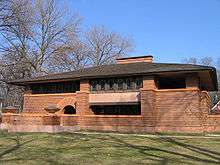
Frank Lloyd Wright spent the first 20 years of his 70-year career in Oak Park, building numerous homes in the community, including his own and Walter Gale House. He lived and worked in the area between 1889 and 1909. One can find Wright's earliest work here, like the Winslow House in neighboring River Forest, Illinois. There are also examples of the first prairie-style houses in Oak Park. He also designed Unity Temple, a Unitarian-Universalist church, which was built between 1905 and 1908. There were several well-known architects and artists that worked in Wright's Oak Park Studio, including Richard Bock, William Eugene Drummond, Marion Mahony Griffin, and Walter Burley Griffin.
Many buildings in Oak Park were built by other Prairie School architects such as George W. Maher, John Van Bergen, and E.E. Roberts.
Oak Park's housing stock reflects the decades of its rapid growth while it was part of the town of Cicero and since 1902 when it became a village. Historic preservation has been a priority since an ordinance passed in 1972 and since revised.[30][31] There are 2,400 historic sites in Oak Park, the majority of which are homes built in the Queen Anne, Prairie School and Craftsman styles of architecture.[32] The Village of Oak Park displays these on line in an interactive web site.[33] Three historic districts recognize the variety of styles often standing next door to each other. The three districts are Frank Lloyd Wright, Ridgeland-Oak Park, and Seward Gunderson,[34] outlined on a map from the Village.[35] A fourth district is under consideration in 2015, of 176 homes built by Thomas Henry Hulbert.[32][36]
The Art Deco style main post office on Lake Street was designed by White and Weber in 1933. It is part of the Ridgeland-Oak Park Historic District.[37]
Points of interest
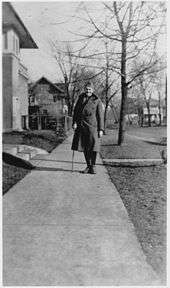
- Frank Lloyd Wright Home and Studio and his Unity Temple
- Ernest Hemingway homes and museum
- Edgar Rice Burroughs homes
- Oak Park Conservatory
- Oak Park-River Forest Historical Society, currently located in the Pleasant Home
- Cheney Mansion
- Seward Gunderson Historic District
- Oak Park and River Forest High School
- Fenwick High School
Notable people
References
- ↑ "2010 Census Population Compared to 2000: Illinois Municipalities/CDPs, Ranked by 2010 Population" (PDF). Retrieved July 6, 2015.
- ↑ "Profile of General Population and Housing Characteristics: 2010 Demographic Profile Data (DP-1): Oak Park village, Illinois". U.S. Census Bureau, American Factfinder. Retrieved March 18, 2013.
- 1 2 3 4 5 "Oak Park History". The Historical Society of Oak Park and River Forest. Retrieved July 6, 2015.
- ↑ "Galena & Chicago Union Railroad". timeline. Chicago Public Library. (subscription required (help)).
- ↑ Bluestone, Daniel M. (December 8, 1983). "RIDGELAND--OAK PARK HISTORIC DISTRICT National Register of Historic Places Nomination Form" (PDF). Oak Park Landmarks Commission (now Historic Preservation Commission). p. 11.
- 1 2 Wiss, Janney, Elstner Associates, Inc. (February 20, 2006). "Village of Oak Park Madison Street Corridor Architectural Historical Survey" (PDF). pp. 3–4. Retrieved July 6, 2015.
- ↑ "Frank Lloyd Wright in Oak Park, Illinois (1889-1909)".
- ↑ "G001 - Geographic Identifiers - 2010 Census Summary File 1". United States Census Bureau. Retrieved 2015-12-25.
- ↑ "Divvy bike sharing coming to Oak Park". The Village of Oak Park. September 29, 2014. Retrieved July 6, 2015.
- ↑ "Annual Estimates of the Resident Population for Incorporated Places: April 1, 2010 to July 1, 2015". Retrieved July 2, 2016.
- ↑ "Census of Population and Housing". Census.gov. Archived from the original on May 11, 2015. Retrieved June 4, 2015.
- ↑ "Oak Park (village), Illinois". QuickFacts. US Census Bureau. May 29, 2015. Retrieved July 6, 2015.
- ↑ "Selected Economic Characteristics: 2009-2011 American Community Survey 3-Year Estimates (DP03): Oak Park village, Illinois". U.S. Census Bureau, American Factfinder. Retrieved March 18, 2013.
- ↑ Davis, Morgan P. (December 21, 2012). "How Oak Park Became Oak Park". The Oak Parker. Retrieved July 6, 2015.
- ↑ "Looking for the best Oak Park apartments? Start at the Oak Park Regional Housing Center". Retrieved July 6, 2015.
- ↑ "Not in Your Front Yard: Why 'For Sale' Signs are Banned in Oak Park". WBEZ. March 21, 2016. Retrieved March 30, 2016.
- ↑ McKenzie,Evan; Ruby, Jay. "Reconsidering the Oak Park Strategy: The Conundrums of Integration" (PDF). Temple University Web Archive in Visual Anthropology. p. 7. Retrieved July 6, 2015.
- ↑ Lothson, Anna (November 7, 2012). "Oak Park has highest voter turnout in suburban Cook County". Wednesday Journal. Retrieved July 6, 2015.
- ↑ "Schools". Oak Park Elementary School District 97.
- ↑ "Strategic Plan". Oak Park Elementary School Distract 97. Retrieved July 6, 2015.
- ↑ "2014 Illinois school report cards, Oak Park Schools". Chicago Tribune. Retrieved July 6, 2015.
- ↑ Oak Park African American Achievement Study Team (May 2003). "The Learning Community Performance Gap at Oak Park River Forest High School" (PDF). p. 18.
- ↑ Andersen, Kevin (December 19, 2006). "Here's what District 97 is doing about 'the gap'". Opinion. Wednesday Journal. Retrieved July 1, 2011.
- ↑ "Ridgeland Common is Now Open!". Retrieved July 6, 2015.
- ↑ Farmer, Marty (June 5, 2014). "Ridgeland Common ready for public". Wednesday Journal. Retrieved July 6, 2015.
- ↑ "Oak Park Public Library". Retrieved July 6, 2015.
- ↑ "Fire Department". The Village of Oak Park. Retrieved July 6, 2015.
- ↑ Rose, Devin (October 18, 2011). "Crime dropped everywhere in Oak Park". Wednesday Journal. Retrieved July 6, 2015.
- ↑ "Oak Park Art League". Retrieved July 6, 2015.
- ↑ Miller, Bryan (September 20, 1990). "Oak Park's dilemma: who controls historic housing?". Chicago Reader. Retrieved July 16, 2015.
- ↑ Doyle, Bridget (February 23, 2012). "Oak Park expands Frank Lloyd Wright historic district: Village Board redraws boundaries to include 444 more homes". Chicago Tribune. Retrieved July 16, 2015.
- 1 2 Inklebarger, Timothy (May 5, 2015). "Hulbert homes may get historic status". Wednesday Journal. Retrieved July 16, 2015.
- ↑ "Historic Resources". The Village of Oak Park. Retrieved July 16, 2015.
- ↑ "The Gunderson Historic District" (PDF). Retrieved July 16, 2015.
- ↑ "Historic District Boundaries". Village of Oak Park. Retrieved July 16, 2015.
- ↑ "The Hulbert Houses Historic District Designation Proposal" (PDF). Oak Park Historic Preservation Commission. Retrieved July 16, 2015.
- ↑ "Ridgeland-Oak Park Historic District" (PDF). Oak Park. Retrieved July 6, 2015.
External links
| Wikimedia Commons has media related to Oak Park, Illinois. |
| Wikivoyage has a travel guide for Oak Park. |
- Village of Oak Park official website
- Visit Oak Park - Official Tourism Site for Oak Park and Western Cook County Illinois
- Oak Park - River Forest Chamber of Commerce
- Oak Park Public Library
- Around Oak Park (community blog)
 |
Elmwood Park | Chicago |  | |
| River Forest and Forest Park | |
Austin, Chicago | ||
| ||||
| | ||||
| Berwyn and Cicero |
